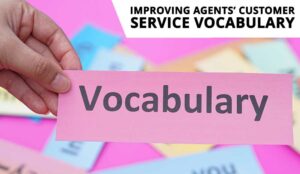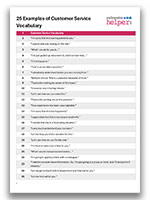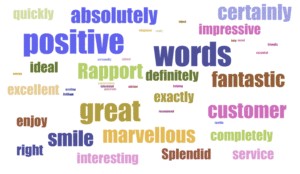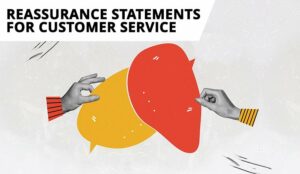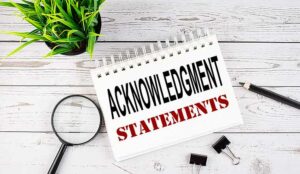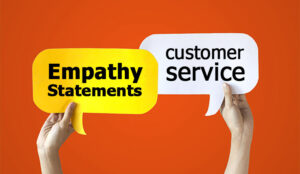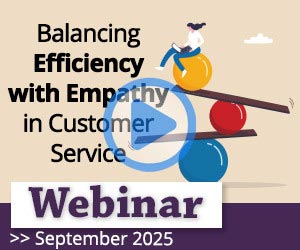The way advisors communicate can make or break a customer interaction. Even small language adjustments can foster better rapport, smoother conversations, and higher customer satisfaction.
Refining service vocabulary helps advisors engage customers with more empathy and a clearer focus on solutions.
Coaching them to use confident, customer-friendly language not only improves interactions but also strengthens relationships, and providing key phrases and reinforcing their use through practice ensures advisors communicate more smoothly and effectively.
In this article we take a look at some great phrases to add to your customer service vocabulary and explore how contact centre leaders can coach agents to improve their service vocabulary.
Customer Service Vocabulary Examples
The words and phrases advisors use can shape the entire customer experience. The right language helps build trust, ease frustration, and guide customers toward solutions.
To get you started we’ve put together some examples of effective customer service vocabulary that can make interactions more empathetic, engaging, and solution-focused.
- “I’m sorry that this has happened to you.”
- “I appreciate you staying on the line.”
- “What I can do for you is…”
- “I’ve just pulled up document X, and I can see that…”
- “I’d be happy to.”
- “That is an excellent question.”
- “I absolutely understand where you are coming from.”
- “Brilliant choice. That is a personal favourite of mine.”
- “Thanks for making me aware of this issue.”
- “It sounds very irritating indeed.”
- “Lets see how we can solve this.”
- “Thanks for alerting me to this problem.”
- “Your experience has been unacceptable.”
- “I’m sorry that this has happened.”
- “I appreciate that this is not easy to deal with.”
- “I realize that this is a frustrating situation.”
- “I very much understand your concern.”
- “Let me help you find a solution for this.”
- “Let’s see how we can fix this now.”
- “I’m here to take care of this for you.”
- “What I would instead recommend is…”
- “I’m going to quickly check with a colleague.”
- “I need to uncover more information. So, I’m just going to put you on hold, and I’ll be back in X minutes.”
- “Let me get in touch with X department and find out for you.”
- “Let me find out for you.”
By incorporating these phrases into conversations, advisors can create a more positive and professional tone.
However, improving customer service vocabulary goes beyond simply using better words—it’s about coaching agents to communicate with confidence, authenticity, and clarity.
Printable – 25 Customer Service Vocabulary Examples
Do you want to share this with your team?
Get your free download of 25 Customer Service Vocabulary Examples now:
Let’s take a look at five key steps to help advisors develop stronger, more effective communication skills.
Five Steps to Improve Your Customer Service Vocabulary
From replacing tired clichés to using more positive, customer-friendly language, these five steps will help advisors build better conversations and enhance the overall customer experience.
1. Give Agents Better Replacements for Customer Service Clichés
Nobody enjoys calling a contact centre. They expect cold, robotic interactions. When advisors turn to clichés, that is what they get.
Of course, many service clichés provide a comfort blanket for agents unsure of what to say. So, banning all such phrases is perhaps not the best approach. A better way to improve is by coaching the use of better alternatives.
If an agent uses any of the clichés below, step in and share the superior phrase. Over time, they will begin to engage in more natural conversations.
| Avoid this cliché… | And say this… |
|---|---|
| “Sorry for any inconvenience.” | “I’m sorry that this has happened to you.” |
| “Thanks for your patience.” | “I appreciate you staying on the line.” |
| “It is company policy.” | “What I can do for you is…” |
| “Our records indicate…” | “I’ve just pulled up document X, and I can see that…” |
| “Not a problem.” | “I’d be happy to.” |
From the set of alternative statements, principles emerge for furthering the customer service vocabulary of agents.
These include:
- Employ personal pronouns – including “I”, “you”, and “we” – to take ownership and create a sense of intimacy.
- Use contractions – such as “I’ve” instead of “I have” to sound more authentic.
- Refocus the conversation on the positive instead of dwelling on the negative
Apply these principles when embarking on a positive scripting initiative, alongside many of the other golden nuggets of advice presented below.
Discover more phrases that irritate customers by delving into our article: Call Centre Etiquette: 15 Things You Should Never Say to a Customer
2. Double-Check Everyone REALLY Understands Contact Centre Jargon
“Complete your ACW.” “Improve your CSAT scores.” “Update the CRM.” Contact centres are rife with jargon such as this. It is crucial agents receive coaching to understand the meaning behind everyday jargon terms like these. Avoid leaving people in the dark.
For leaders and managers, there is likely additional jargon to learn. “Check the SOPs.” “Look at the CEM strategy.” “Inspect the BI.” Many contact centres share this jargon. Some will have their own terms. Whatever the case, create a jargon dictionary to avoid misunderstandings.
Such a jargon guide may include the terms above, which typically stand for:
- ACW = After Call Work
- CSAT = Customer Satisfaction
- CRM = Customer Relationship Management (system)
- SOPs = Standard Operating Procedures
- CEM = Customer Experience Management
- BI = Business Intelligence
Providing a dictionary – filled with the necessary customer service vocabulary – is helpful. After all, there is often a lot of jargon to get to grips with. So far, we have so far only touched on the acronyms!
However, contact centre abbreviations serve a purpose, particularly those relating to agents. Working them into the CRM system speeds up wrap time, reducing overall handling times.
Typing DLV instead of “delivery” is an excellent example. CUST – as opposed to “customer” – is another. Add these up, and agents can shave precious seconds off the call. Just avoid using them when engaging with customers, who will have no idea what they mean.
3. Add in Positive Words for Better Conversations
Once upon a time, many contact centres asked advisors to avoid negative words, such as “no”, “can’t”, and “don’t”. The concept, however, proved unsuccessful as many advisors struggled to think of “workarounds”, blocking the flow of natural conversation.
However, despite its failure, there is logic to avoiding such negatives. As the BRM institute reports: “Negative words, whether spoken, heard, or thought, not only cause situational stress but also contribute to long-term anxiety.”
A better approach is to reinforce the value of positive words in coaching to avoid such distress.
For example, when call listening, make a note if the advisor says something negative, such as: “I can’t do that.” Such a statement will likely cause an escalation, as the customer will want to speak with someone who can. Coaching a more positive alternative, such as: “What I can do for you is…” will prevent an uncomfortable conversation.
To go further, ask advisors to harness the power of positive words to build rapport with customers. When relaying good news, encouraging the customer to share more information, or promoting a solution, spread infectious positive energy with the words below.
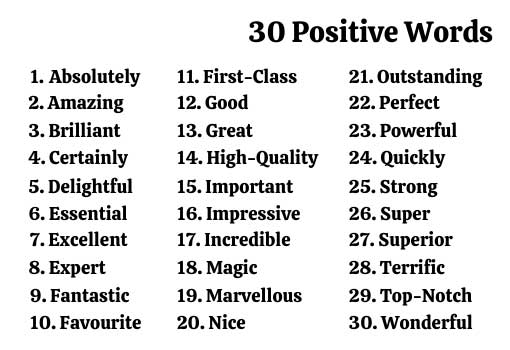
Complimenting customers is another good use of these words. Consider the phrases below and how they can positively impact contact centre conversations.
- “That is an excellent question.”
- “I absolutely understand where you are coming from.”
- “Brilliant choice. That is a personal favourite of mine.”
Just be cautious that agents deliver these with an enthusiastic, friendly tone of voice. Authenticity is critical, and advisors must use active listening to unlock the best opportunities.
Deliver friendly contact centre experiences with our 50 Great Complimentary Words to Use in Customer Service
4. Share Vocabulary for Tricky Customer Scenarios
Angry customers are in no short supply. In the UK, research shows that consumers are becoming increasingly irate, which significantly influences the advisor experience.
However, it is not just anger that advisors must deal with. There are many other challenging “types” of customers that are impatient, indecisive and sometimes stressed.
Most often, these negative emotions stem from a sense of anxiety. Using vocabulary and emotional intelligence, agents can reassure customers and bring them back onside.
A good practice here is to use AER Statements which group acknowledgement, empathy and reassurance into one super-statement. For example:
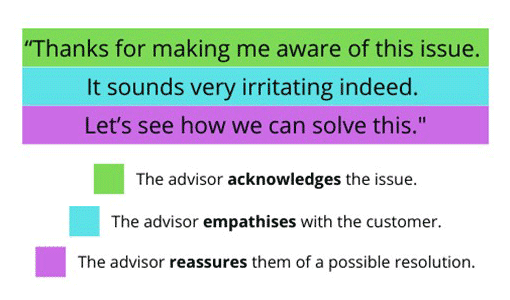
The acknowledgement helps to vindicate the customer’s reaction. Following this up with empathy enables the advisor to show that they understand why the customer is anxious. Reassurance that a solution is possible then deflates the tension further, offering a notion of teamwork in the process.
Of course, there are other helpful techniques to defuse customer anxiety. For example, letting the customer vent, managing emotions, and simply showing patience can all take the heat out of the situation.
But if advisors can stitch together acknowledgement, empathy and reassurance statements, they can use their customer service vocabulary to excellent effect.
Here are a few more examples for advisors to add to their repertoire:
- “Thanks for alerting me to this problem.”
- “Your experience has been unacceptable.”
- “I’m sorry that this has happened.”
If you are looking for more examples of acknowledgement statements and how to use them in customer conversations, read our article: The Top 10 Acknowledgement Statements for Customer Service
Empathy Statements
- “I appreciate that this is not easy to deal with.”
- “I realize that this is a frustrating situation.”
- “I very much understand your concern.”
If you are looking for more information on empathy statements, along with examples and advice on how to use them, read our article: Empathy Statements for Customer Service With Examples
Reassurance Statements
- “Let me help you find a solution for this.”
- “Let’s see how we can fix this now.”
- “I’m here to take care of this for you.”
If you are looking for advice on how to use reassurance statements in customer conversations, as well as examples you can use, read our article: Reassurance Statements in Customer Service – With Examples
Skilled agents can blend such statements to meet the needs of individual customers. They may then quickly refocus the conversation towards the positive: the resolution.
5. Look Out for Customer Service Vocabulary Nightmares
While there are lots of excellent words and phrases to add to an advisor’s customer service vocabulary, there are many to exclude too. These go beyond the odd cliché.
After all, a poor turn of phrase can make a customer’s blood boil, destroying all rapport in the process. Sometimes, that is all it takes.
Consider a scenario where – at the end of a call – the advisor says: “Is there anything else I can help you with?” If the initial problem has no resolution, such a comment can foster resentment.
The graphic below presents another example, which is so common that we have turned it into a meme.

Why does this statement bother customers so much? Because the modern customer is digital-first. It is unlikely that they did not look online before calling. Chances are, that is where they found the phone number. As such, it can undermine their intelligence.
So, avoid fanning the flames of customer dissatisfaction with such statements – more of which are visible in the table below.
| Avoid this statement… | Say this instead… |
|---|---|
| “You should not have done that.” | “What I would instead recommend is…” |
| “I’m new here.” | “I’m going to quickly check with a colleague.” |
| “I’m putting you on hold.” | “I need to uncover more information. So, I’m just going to put you on hold, and I’ll be back in X minutes.” |
| “That is not my department.” | “Let me get in touch with X department and find out for you.” |
| “I don’t know.” | “Let me find out for you.” |
One final example is the phrase: “It is company policy.” It is not a clear-cut reason to say “no” to a customer, making the advisor seem evasive. With a bad taste in their mouth, customer discontent grows and the call is more likely to turn unpleasant – perhaps even “nightmarish”.
Eager to expand your customer service vocabulary even further? Then delve into the following articles:
- Best Tips, Phrases and Words to Use for Building Rapport
- Customer Service Language: Changing the Language of Your Contact Centre
- The Phonetic Alphabet – A Simple Way to Improve Customer Service
Author: Charlie Mitchell
Reviewed by: Robyn Coppell
Published On: 3rd Aug 2022 - Last modified: 21st Oct 2025
Read more about - Customer Service Strategy, Call Handling, Charlie Mitchell, Customer Service, Editor's Picks, Empowering Agents, Free Downloads, Language, Service Strategy, Soft Skills





